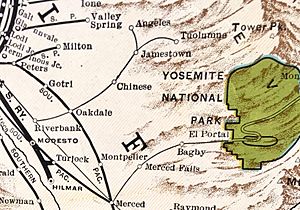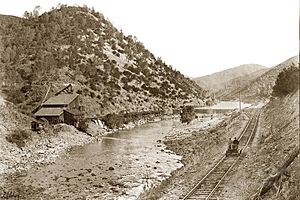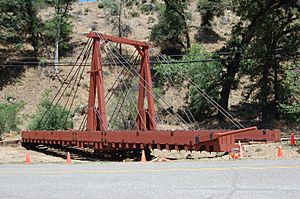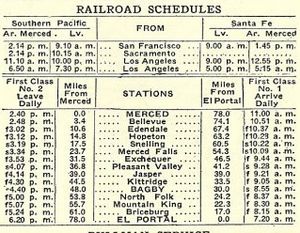Yosemite Valley Railroad facts for kids
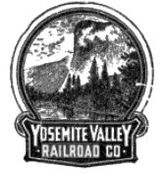 |
|
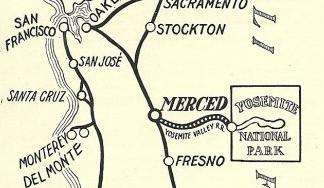
Route of Yosemite Valley Railroad.
|
|
| Overview | |
|---|---|
| Headquarters | Merced, California |
| Locale | Merced River, California |
| Dates of operation | 1902–1945 |
| Technical | |
| Track gauge | 4 ft 8 1⁄2 in (1,435 mm) standard gauge |
| Electrification | none |
| Length | 80 miles (130 km) |
| Other | |
| Website | Yosemite Valley Railroad |
The Yosemite Valley Railroad (YVRR) was a special train line that ran from 1907 to 1945 in California. It mostly followed the Merced River from Merced all the way to the edge of Yosemite National Park. This railroad carried both people and goods.
Even though it was called the Yosemite Valley Railroad, the trains did not go into Yosemite Valley itself. Building railroads is not allowed inside National Parks. Passengers would get off the train at the park boundary in El Portal, California. From there, they could stay at the Hotel Del Portal or take a stagecoach. Later, starting in 1913, they could take a motor coach to reach Yosemite Valley.
The railroad started to have problems in the 1940s. A big lumber company and a cement company, which used the train to ship their products, stopped operating. This meant the railroad lost most of its freight business. Also, more people started using cars and buses on the new Yosemite All-Year Highway (now California State Route 140). During World War II, fewer people traveled for fun. All these things led to the railroad closing down. The last regular train ran on August 24, 1945.
Contents
Building the Railroad
The Yosemite Valley Railroad company was officially started on December 18, 1902. It was founded by John S. Drum, William B. Bosley, Sydney M. Ehrman, Thomas Turner, and Joseph D. Smith in San Francisco. This was a "standard-gauge" railway, meaning its tracks were the same width as most other railroads.
The main line stretched about 30 miles (48 km) from Merced into the Merced Canyon. It connected towns like Snelling, Merced Falls, Exchequer, and Bagby. From there, it went another 50 miles (80 km) to El Portal, California. Besides passengers and mining products, the railroad also carried lumber from local companies. This lumber was taken to Merced Falls to be cut into boards at sawmills located near the Merced River.
How the Railroad Changed Over Time
In 1926, a new dam called Exchequer Dam was built. This dam created Lake McClure, which flooded part of the railroad tracks. But the railway was rebuilt and moved around the new lake.
Later, in the mid-1940s, floods and landslides caused a lot of damage. Nearly 30 miles (48 km) of the tracks in Merced Canyon were harmed. When Exchequer Dam was made even bigger in the 1960s, some parts of the rerouted tracks went underwater again. Today, if the water level in Lake McClure gets very low during dry periods, you can still see some of the old railroad tunnels. Other tunnels in Merced Canyon are now used for road traffic.
Famous Passengers on the YVRR
The Yosemite Valley Railroad carried many important people. Two United States presidents rode on its trains. William Howard Taft traveled on the YVRR in October 1909. Later, Franklin D. Roosevelt rode the train on July 15, 1938.
What Remains of the Yosemite Valley Railroad?
Even though the railroad stopped running, some parts of it still exist today. The National Park Service moved several old structures from Bagby to El Portal. This includes the original turntable, which was a big spinning platform used to turn locomotives around.
One of the few surviving train cars is Caboose No. 15. A caboose is the last car on a freight train, often used by the crew. This caboose is also located in El Portal. Another important piece is Locomotive 29. After the YVRR closed, this train engine was sold to a railroad in Mexico. Today, it is on display in Veracruz, Mexico, and is the only YVRR locomotive that still exists.
Images for kids
-
Yosemite Valley RR Caboose No. 15 with Hetch Hetchy RR Shay No. 6 in El Portal.


